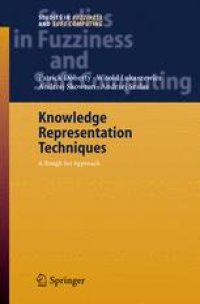
Ebook: Knowledge Representation Techniques: A Rough Set Approach
- Tags: Appl.Mathematics/Computational Methods of Engineering, Artificial Intelligence (incl. Robotics)
- Series: Studies in Fuzziness and Soft Computing 202
- Year: 2006
- Publisher: Springer-Verlag Berlin Heidelberg
- Edition: 1
- Language: English
- pdf
The basis for the material in this book centers around a long term research project with autonomous unmanned aerial vehicle systems. One of the main research topics in the project is knowledge representation and reasoning. The focus of the research has been on the development of tractable combinations of approximate and nonmonotonic reasoning systems. The techniques developed are based on intuitions from rough set theory. Efforts have been made to take theory into practice by instantiating research results in the context of traditional relational database or deductive database systems. This book contains a cohesive, self-contained collection of many of the theoretical and applied research results that have been achieved in this project and for the most part pertain to nonmonotonic and approximate reasoning systems developed for an experimental unmanned aerial vehicle system used in the project. This book should be of interest to the theoretician and applied researcher alike and to autonomous system developers and software agent and intelligent system developers.
The basis for the material in this book centers around a long term research project with autonomous unmanned aerial vehicle systems. One of the main research topics in the project is knowledge representation and reasoning. The focus of the research has been on the development of tractable combinations of approximate and nonmonotonic reasoning systems. The techniques developed are based on intuitions from rough set theory. Efforts have been made to take theory into practice by instantiating research results in the context of traditional relational database or deductive database systems. This book contains a cohesive, self-contained collection of many of the theoretical and applied research results that have been achieved in this project and for the most part pertain to nonmonotonic and approximate reasoning systems developed for an experimental unmanned aerial vehicle system used in the project. This book should be of interest to the theoretician and applied researcher alike and to autonomous system developers and software agent and intelligent system developers.
The basis for the material in this book centers around a long term research project with autonomous unmanned aerial vehicle systems. One of the main research topics in the project is knowledge representation and reasoning. The focus of the research has been on the development of tractable combinations of approximate and nonmonotonic reasoning systems. The techniques developed are based on intuitions from rough set theory. Efforts have been made to take theory into practice by instantiating research results in the context of traditional relational database or deductive database systems. This book contains a cohesive, self-contained collection of many of the theoretical and applied research results that have been achieved in this project and for the most part pertain to nonmonotonic and approximate reasoning systems developed for an experimental unmanned aerial vehicle system used in the project. This book should be of interest to the theoretician and applied researcher alike and to autonomous system developers and software agent and intelligent system developers.
Content:
Front Matter....Pages I-VI
Front Matter....Pages I-VI
Introduction....Pages 3-16
Basic Notions....Pages 17-38
Rough Sets....Pages 39-56
Relational and Deductive Databases....Pages 57-76
Non-Monotonic Reasoning....Pages 77-99
Front Matter....Pages I-VI
Rough Knowledge Databases....Pages 103-127
Combining Rough and Crisp Knowledge....Pages 129-142
Weakest Sufficient and Strongest Necessary Conditions....Pages 143-158
CAKE: Computer Aided Knowledge Engineering....Pages 159-179
Formalization of Default Logic Using CAKE....Pages 181-212
A UAV Scenario: A Case Study....Pages 213-226
Front Matter....Pages I-VI
Information Granules....Pages 229-243
Tolerance Spaces....Pages 245-276
A Rough Set Approach to Machine Learning....Pages 277-309
UAV Learning Process: A Case Study....Pages 311-320
Back Matter....Pages 321-342
The basis for the material in this book centers around a long term research project with autonomous unmanned aerial vehicle systems. One of the main research topics in the project is knowledge representation and reasoning. The focus of the research has been on the development of tractable combinations of approximate and nonmonotonic reasoning systems. The techniques developed are based on intuitions from rough set theory. Efforts have been made to take theory into practice by instantiating research results in the context of traditional relational database or deductive database systems. This book contains a cohesive, self-contained collection of many of the theoretical and applied research results that have been achieved in this project and for the most part pertain to nonmonotonic and approximate reasoning systems developed for an experimental unmanned aerial vehicle system used in the project. This book should be of interest to the theoretician and applied researcher alike and to autonomous system developers and software agent and intelligent system developers.
Content:
Front Matter....Pages I-VI
Front Matter....Pages I-VI
Introduction....Pages 3-16
Basic Notions....Pages 17-38
Rough Sets....Pages 39-56
Relational and Deductive Databases....Pages 57-76
Non-Monotonic Reasoning....Pages 77-99
Front Matter....Pages I-VI
Rough Knowledge Databases....Pages 103-127
Combining Rough and Crisp Knowledge....Pages 129-142
Weakest Sufficient and Strongest Necessary Conditions....Pages 143-158
CAKE: Computer Aided Knowledge Engineering....Pages 159-179
Formalization of Default Logic Using CAKE....Pages 181-212
A UAV Scenario: A Case Study....Pages 213-226
Front Matter....Pages I-VI
Information Granules....Pages 229-243
Tolerance Spaces....Pages 245-276
A Rough Set Approach to Machine Learning....Pages 277-309
UAV Learning Process: A Case Study....Pages 311-320
Back Matter....Pages 321-342
....